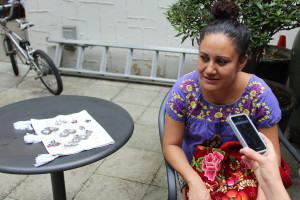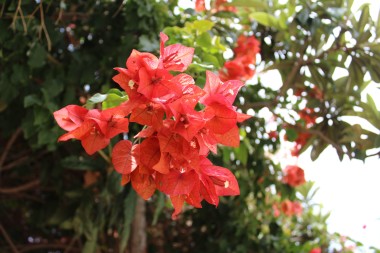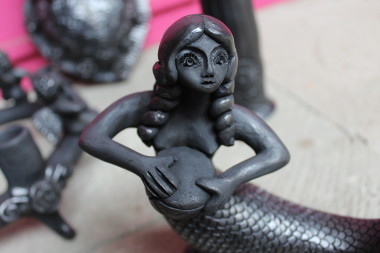Donaji of Antiguas Maravillas and her family create a wide variety of artwork and jewelry: an array of necklaces, earrings, rings, bracelets, religious art, belts of silver, combs, ancient models and figures with dazzling details of Donaji’s metal artwork. Donaji explains that she, along with her entire family, uses the delicate filigree method of making their metal jewelry. In terms of how she learned, Donaji smiles and says, “I began when I was very little. I learned it by tradition. My father learned from his older brother. My mother learned from living with my father. There are more girls in the house, and so as we grew up, we studied, learned, helped, supported, and worked on jewelry with our family. Around 15 or 16 years old, we became more independent and succeeded on pieces.” The filigree method that Donaji learned typically involves using gold and silver to make tiny beads or twisted threads, or both in combination. These can then be meshed together or put onto the surface of an object of the same metal and arranged in artistic decorations. Many designs resemble lace and is a technique of Oaxaca that other jewelry makers also use in the region, although it is said to have originated in Asia.
While the technique is used widely, Donaji states that her family’s art in particular is unique, as everything is made by hand and it takes a lot of dedication. In addition, some of their pieces are used in religion in Oaxaca and are part of the culture in the area. Many people who travel here will agree too. Many Chinese Oaxacans come to the store for pieces, as well as people who practice various religions, such as the Zapotec religion of Isthmus. Thus, in some of the designs, there is religious significance. Many pieces have the letter “M” on them, for the Virgin Mary. These may also be surrounded or made up of lilacs and rivers in Mary’s honor. Additionally, some pieces contain gold and designs of tradition and history. However, other pieces do not have as much religious significance, and their names and designs may be more for aesthetic pleasure.
Even so, Donaji describes her family’s artwork as full of tradition and history. There are workshops within core families in the towns, and Donaji believes it unites the families within because they all work together. In addition, the art has been in her family and Oaxaca for many years. Thus, it is of the utmost importance to transmit the artwork to the next generation and others. This includes the importance of the artwork and its tradition in one’s life, especially if one wants to learn! Learning the art style takes a lot of time; beyond the technique, there is a lot of history to pass on as well.
The cost of each piece depends on how much work was put into the piece. The price can range from 390 pesos for some of the smaller, less detailed pieces to about 20,000-30,000 pesos for the best of their collection. Most are not so costly and are affordable, whether they are small or large. While the family does not have a store, Donaji states that their workshop is twenty minutes away from downtown Oaxaca. People come directly to them, and they show the artwork in some expositions. They also have a Facebook page, titled “Antiguas Maravillas,” but they do not sell their art pieces through the site. Beyond the workshop, their artwork can be seen and bought in several museums in Oaxaca. Most notably, they are in the Museo de Palacio.

















